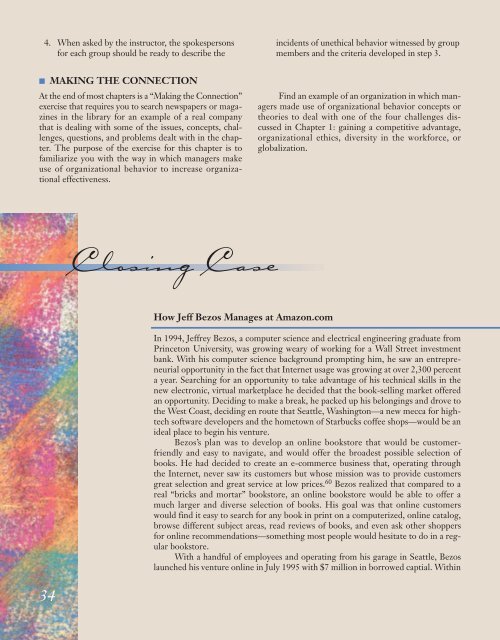chapter - Pearson
chapter - Pearson
chapter - Pearson
Create successful ePaper yourself
Turn your PDF publications into a flip-book with our unique Google optimized e-Paper software.
4. When asked by the instructor, the spokespersons<br />
for each group should be ready to describe the<br />
incidents of unethical behavior witnessed by group<br />
members and the criteria developed in step 3.<br />
■ MAKING THE CONNECTION<br />
At the end of most <strong>chapter</strong>s is a “Making the Connection”<br />
exercise that requires you to search newspapers or magazines<br />
in the library for an example of a real company<br />
that is dealing with some of the issues, concepts, challenges,<br />
questions, and problems dealt with in the <strong>chapter</strong>.<br />
The purpose of the exercise for this <strong>chapter</strong> is to<br />
familiarize you with the way in which managers make<br />
use of organizational behavior to increase organizational<br />
effectiveness.<br />
Find an example of an organization in which managers<br />
made use of organizational behavior concepts or<br />
theories to deal with one of the four challenges discussed<br />
in Chapter 1: gaining a competitive advantage,<br />
organizational ethics, diversity in the workforce, or<br />
globalization.<br />
Closing Case<br />
How Jeff Bezos Manages at Amazon.com<br />
In 1994, Jeffrey Bezos, a computer science and electrical engineering graduate from<br />
Princeton University, was growing weary of working for a Wall Street investment<br />
bank. With his computer science background prompting him, he saw an entrepreneurial<br />
opportunity in the fact that Internet usage was growing at over 2,300 percent<br />
a year. Searching for an opportunity to take advantage of his technical skills in the<br />
new electronic, virtual marketplace he decided that the book-selling market offered<br />
an opportunity. Deciding to make a break, he packed up his belongings and drove to<br />
the West Coast, deciding en route that Seattle, Washington—a new mecca for hightech<br />
software developers and the hometown of Starbucks coffee shops—would be an<br />
ideal place to begin his venture.<br />
Bezos’s plan was to develop an online bookstore that would be customerfriendly<br />
and easy to navigate, and would offer the broadest possible selection of<br />
books. He had decided to create an e-commerce business that, operating through<br />
the Internet, never saw its customers but whose mission was to provide customers<br />
great selection and great service at low prices. 60 Bezos realized that compared to a<br />
real “bricks and mortar” bookstore, an online bookstore would be able to offer a<br />
much larger and diverse selection of books. His goal was that online customers<br />
would find it easy to search for any book in print on a computerized, online catalog,<br />
browse different subject areas, read reviews of books, and even ask other shoppers<br />
for online recommendations—something most people would hesitate to do in a regular<br />
bookstore.<br />
With a handful of employees and operating from his garage in Seattle, Bezos<br />
launched his venture online in July 1995 with $7 million in borrowed captial. Within<br />
34

















